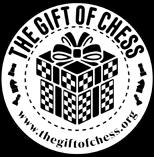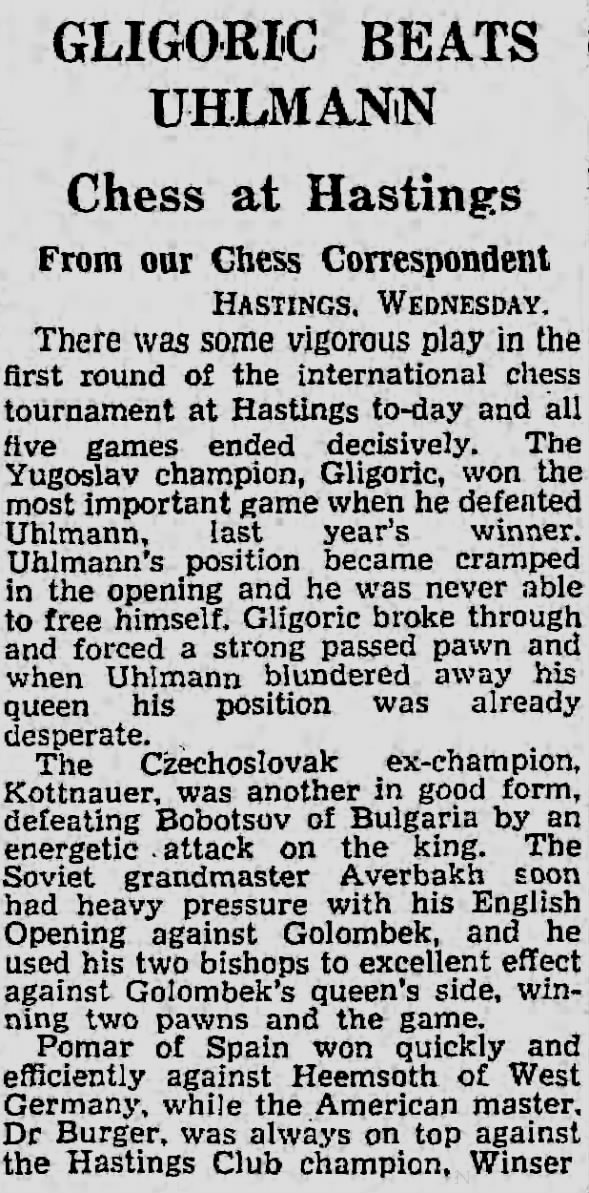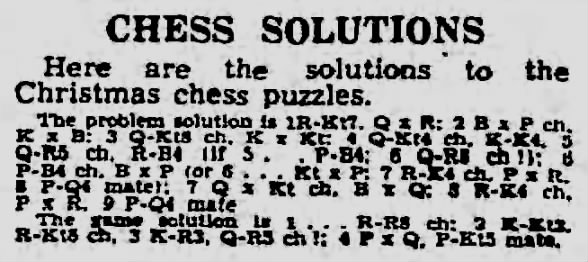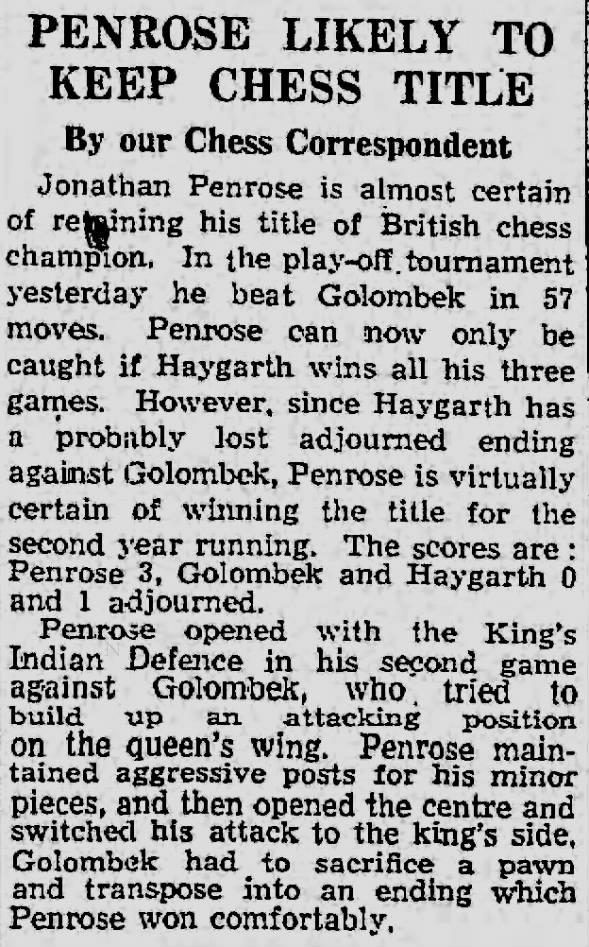< Prev
Index
Next >
 Chess 22 Oct 1959, Thu The Guardian (London, Greater London, England) Newspapers.com
Chess 22 Oct 1959, Thu The Guardian (London, Greater London, England) Newspapers.com
Chess
The Guardian, Chess, Thursday, October 22, 1959, Greater London, England Problem No. 547 By S. Wright Wood...
Posted by Bobby Fischer's True History on Wednesday, May 18, 2022
Problem No. 547 By S. Wright Wood (Shipley)
Black (7)
White (10)
White mates in two moves.
FEN 8/4K3/5P1B/3Np1R1/1Qnpk3/5pP1/N1P5/4r1bB w - - 0 1
Solution 1. Ne3 dxe3 2. Qxc4#
Rooks round the corner
We are so accustomed to seeing king's side attacks in which the rooks are posted behind a general advance of the pawns that it takes an unusual effort of the imagination to foresee a queen's rook joining in a direct assault via the QR file. The manoeuvre occurred in Gligoric-Smyslov, published a fortnight ago, and the following game is also from the candidates' tournament in Bled. Incidentally, for Black to win a Caro-Kann by a king's side attack must be unique in master play.
Robert James Fischer vs Paul Keres
Bled-Zagreb-Belgrade Candidates (1959), Bled, Zagreb & Belgrade YUG, rd 8, Sep-18
Caro-Kann Defense: Two Knights Attack. Mindeno Variation Exchange Line (B11) 0-1
- An innovation: in two of the Fischer-Petrosian games Black played 9. … BxBch.
- A weak reply, which leaves the white queen's wing full of holes. Far better is 10. P-B3 B-K2; 11. B-B1 P-K4; 12. B-N2 QN-Q2; 13. O-O P-B4; 14. N-Q2 O-O; 15. N-B4 Q-B2; 16. P-QR4, when White's position is preferable—he has the two bishops and can aim for a king's side attack with P-KB4-5.
- A second mistake [illegible] which White is driven right on the defensive. Correct is 12. P-QR4, so as to develop the knight at QR3 and QB4, although even then Black maintains some advantage by 12. … N-R3; followed by … N-QN5.
- The immediate 13. … P-B4; 14. P-K5 N-Q4 would enable White to weaken the enemy king's position by 15. Q-N4.
- White [illegible] a reasonable plan and has to make this cumbersome move to save the pawn (15. … PxP; 16. R-N2). If instead 15. PxP Q-N7 wins.
- A sound blockading reply, which prevents White developing counterplay with 18. P-K5 and 19. P-KB4.
- A serious positional blunder, which leads directly to defeat. In the sequel, Keres utilises the gift of his K4 square to direct all his pieces against the white king. The correct plan is 21. P-B5, intending the counter-attack P-KN4-5; Black would reply 21. … B-K2 and continue his pressure on the QB file.
- And here comes the rook round the corner.
- 26. BxB QxB; 27. B-N2 would hold out slightly longer, but Black would still obtain a winning attack after 27. … R-KN4; 28. K-B2 N-K4; 29. Q-K2 (29. Q-B4 R-N5; 30. Q-B5 P-KN3 wins the queen), N(K4)-N5ch; 30. K-K1 QxPch.
- Giving up two pieces for a rook, but if 27. PxN, R-R5; 28. B-R3 BxBP and White's game collapses.
- A field day for Black's pieces, and a very satisfying win for Keres, who had lost to Fischer in their two previous encounters. When the tearful Bobby resigned, Keres comforted him with the words, “You, too, must lose sometime.” However, Fischer took ample revenge in their fourth meeting, to be given in the “Guardian” next week.
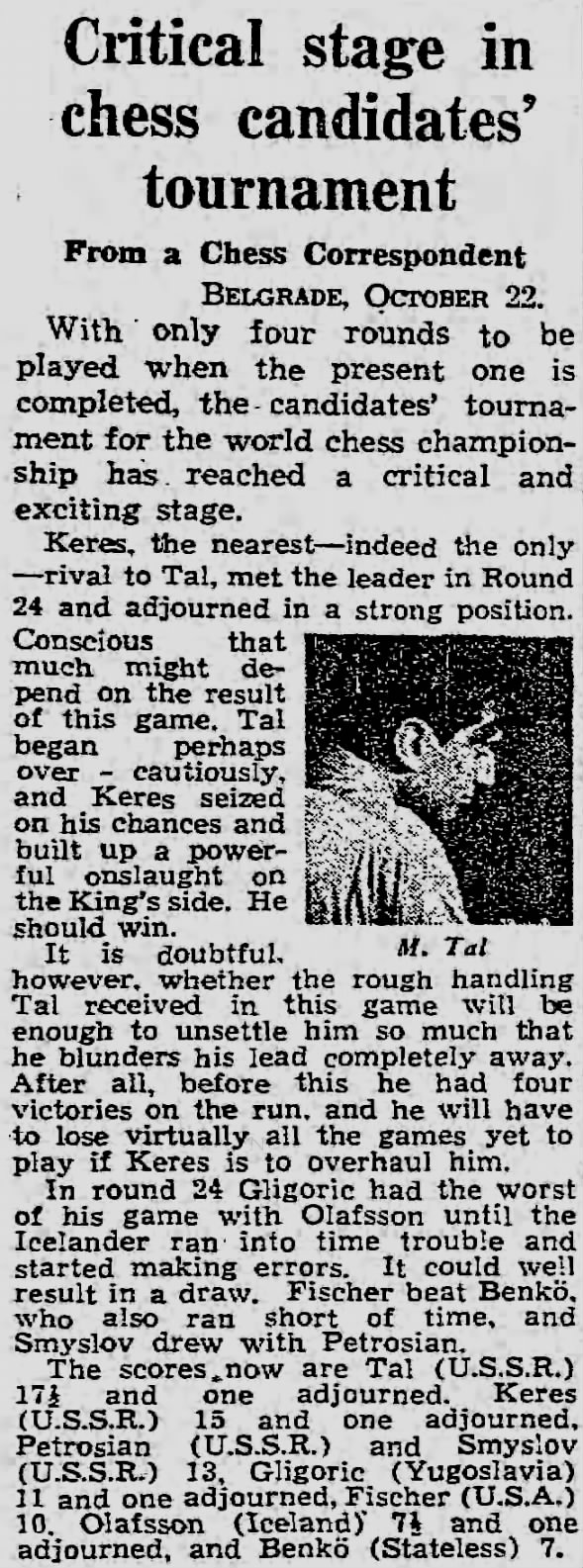 Critical Stage In Chess Candidates' Tournament 23 Oct 1959, Fri The Guardian (London, Greater London, England) Newspapers.com
Critical Stage In Chess Candidates' Tournament 23 Oct 1959, Fri The Guardian (London, Greater London, England) Newspapers.com
Critical stage in chess candidates' tournament
From a Chess Correspondent
Belgrade, October 22.
With only four rounds to be played when the present one is completed, the candidates' tournament for the world chess championship has reached a critical and exciting stage.
Keres, the nearest—indeed the only—rival to Tal, met the leader in Round 24 and adjourned in a strong position. Conscious that much might depend on the result of this game. Tal began perhaps over-cautiously, and Keres seized on his chances and built up a powerful onslaught on the King's side. He should win.
It is doubtful, however, whether the rough handling Tal received in this game will be enough to unsettle him so much that he blunders his lead completely away. After all, before this he had four victories on the run, and he will have to lose virtually all the games yet to play if Keres is to overhaul him.
In round 24 Gligoric had the worst of his game with Olafsson until the Icelander ran into time trouble and started making errors. It could well result in a draw. Fischer beat Benko, who also ran short of time, and Smyslov drew with Petrosian.
The scores now are Tal (U.S.S.R.) 17½ and one adjourned. Keres (U.S.S.R.) 15 and one adjourned, Petrosian (U.S.S.R.) and Smyslov (U.S.S.R.) 13, Gligoric (Yugoslavia) 11 and one adjourned, Fischer (U.S.A.) 10. Olafsson (Iceland) 7½ and one adjourned, and Benko (Stateless) 7.
 Excitement in World Chess 24 Oct 1959, Sat The Guardian (London, Greater London, England) Newspapers.com
Excitement in World Chess 24 Oct 1959, Sat The Guardian (London, Greater London, England) Newspapers.com
Excitement in world chess
Tal takes his revenge on Smyslov
From a Chess Correspondent
Belgrade, October 23.
With their 24th round encounter in the world chess championship candidates' tournament adjourned, Tal and Keres were content with quick draws in round 25, the former against Olafsson and the latter against Petrosian. Smyslov beat Benko, and the Gligoric-Fischer game was adjourned in a drawn position.
The scores now are Tal (U.S.S.R.) 18 and one adjourned. Keres (U.S.S.R.) 15½ and one adjourned. Smyslov (U.S.S.R.) 14, Petrosian (U.S.S.R.) 13½, Gligoric (Yugoslavia) 11 and two adjourned, Fischer (U.S.A.) 10 and one adjourned. Olafsson (Iceland) 8 and one adjourned, and Benko (stateless) 7.
These last few rounds have been overshadowed by a personal issue between Tal and Smyslov. On the eve or their encounter in round 22, Smyslov, a former world champion, gave an interview to one of the biggest Yugoslav dailies, stating openly that Tal's successes were, in his opinion, undeserved; he even qualified Tal's courageous combinations as “tricks.”
In the crowded tournament room, which seats almost 3,000 spectators, there was therefore keen excitement when the two met face to face. Although his bad start in the tournament spoiled Smyslov's chances of first place, a win at this stage could have evened the chances of Keres and Tal. He chose to play for a win, although his opponent had the advantage of the first move.
Tal did not attempt to prove that his style was correct, but only that it was effective enough, even when used against a former world champion. He chose to weaken his Queen's side, only to place his pieces more actively. In the meantime, Smyslov rearranged his forces very harmoniously, with strategical plans in mind. Tal's goals were more direct.
The tension rose from move to move, in the game as well as among the public. However, just when Tal's pieces took their ideal aggressive positions it became clear that his ideas had come to a dead end, and he was suddenly unable to strengthen his pressure. Smyslov's strategy seemed to triumph; the masters present had already decided that Smyslov, had breathed fresh ideas into the whole, opening line, so that it could be expected to be followed in years to come.
Threatened with a counter-attack, however, Tal decided to sacrifice, a piece in his usual manner, just to complicate the position. It was not difficult for Smyslov to find the right answers at first; but then, lacking time, he began to overestimate his material advantage, moving his pieces here and there just to pass the time control.
Given his chance, Tal used it so fast that it seemed he had made something; out of nothing. Having mined Black's centre, he offered a quite unexpected sacrifice of his rook just before the moment when the game had to be adjourned. Smyslov thought for half an hour, and did not seal his move, deciding to resign instead. The resounding applause did not seem quite just for Smyslov had the upper hand almost throughout the game.
 Tal Loses Round, But Still Ahead 26 Oct 1959, Mon The Guardian (London, Greater London, England) Newspapers.com
Tal Loses Round, But Still Ahead 26 Oct 1959, Mon The Guardian (London, Greater London, England) Newspapers.com
Tal Loses Round, But Still Ahead
From a Chess Correspondent
Caption: Tal, the leader, was beaten by Keres in the twenty-fourth round of the world chess championship candidates' tournament in Yugoslavia, after four wins in succession.
Belgrade, October 25.
The question of who shall meet Botvinnik for the world chess title next year is now virtually settled, and the world champion has already said he has begun to study the style of his new rival, Mikhail Tal.
This remains true in spite of Keres's win over the leader in the adjourned 24th round game. In this, Tal lost two pawns and Keres was able to force a neat ending.
Keres's win makes the finish more interesting, but cannot change its outcome. His only consolation is that the second place here gives one the right automatically to compete at the next candidates' tournament three years from now. The Gligoric-Fischer game was drawn.
The leading scores are:
Tal (U.S.S.R.), 18;
Keres (U.S.S.R.), 16½;
Smyslov (U.S.S.R.), 14;
Petrosian (U.S.S.R.), 13½;
Gligoric (Yugoslavia), 11½;
Fischer (U.S.A.), 10½;
Olafsson (Iceland), 9;
and Benko (stateless), 7.
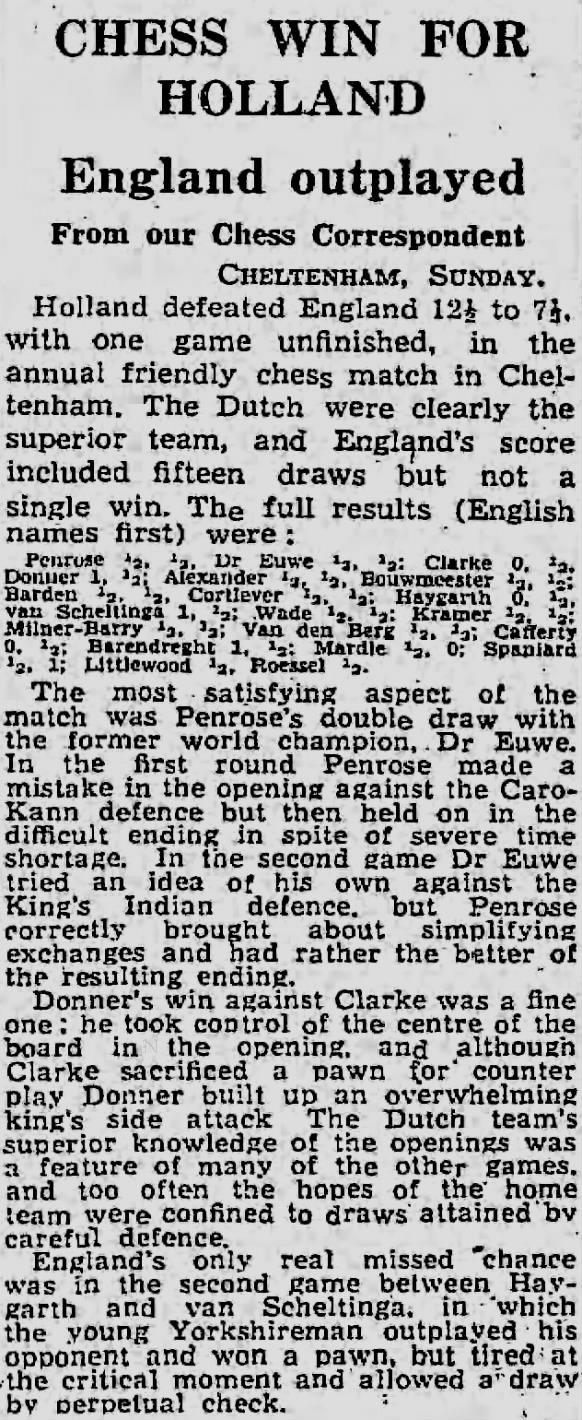 Chess Win For Holland 26 Oct 1959, Mon The Guardian (London, Greater London, England) Newspapers.com
Chess Win For Holland 26 Oct 1959, Mon The Guardian (London, Greater London, England) Newspapers.com
CHESS WIN FOR HOLLAND
England outplayed
From our Chess Correspondent
Cheltenham, Sunday.
Holland defeated England 12½ to 7½, with one game unfinished, in the annual friendly chess match in Cheltenham. The Dutch were clearly the superior team, and England's score included fifteen draws but not a single win. The full results (English names first) were:
Penrose ½, ½;
Dr. Euwe ½, ½;
Clarke 0, ½;
Donner 1, ½;
Alexander ½, ½;
Bouwmeester ½, ½;
Barden ½, ½;
Cortlever ½, ½;
Haygarth 0, ½;
van Scheltinga 1, ½;
Wade ½, ½;
Kramer ½, ½;
Milner-Barry ½, ½;
Van den Berg ½, ½;
Cafferty 0, ½;
Barendreght 1, ½;
Mardle ½, 0;
Spaniard ½, 1;
Littlewood ½;
Roessel ½.
The most satisfying aspect of the match was Penrose's double draw with the former world champion, Dr Euwe. In the first round Penrose made a mistake in the opening against the Caro-Kann defence but then held on in the difficult ending in spite of severe time shortage. In the second game Dr Euwe tried an idea of his own against the King's Indian defence, but Penrose correctly brought about simplifying exchanges and had rather the better of the resulting ending.
Donner's win against Clarke was a fine one: he took control of the centre of the board in the opening, and although Clarke sacrificed a pawn for counter play Donner built up an overwhelming king's side attack. The Dutch team's superior knowledge of the openings was a feature of many of the other games, and too often the hopes of the home team were confined to draws attained by careful defence.
England's only real missed chance was in the second game between Haygarth and van Scheltinga, in which the young Yorkshireman outplayed his opponent and won a pawn, but tired at the critical moment and allowed a draw by perpetual check.
 Fischer's Fine Play Against Tal in Chess Tournament 28 Oct 1959, Wed The Guardian (London, Greater London, England) Newspapers.com
Fischer's Fine Play Against Tal in Chess Tournament 28 Oct 1959, Wed The Guardian (London, Greater London, England) Newspapers.com
Fischer's fine play against Tal in chess tournament
From a Chess Correspondent
Belgrade, October 27.
Two intensely exciting games have transformed the final stages of the candidates' tournament for the world chess championship—that in which the former world champion Smyslov, playing White, lost to the Yugoslav, Gligoric, in eighteen moves, and that in which Bobby Fischer, the United States prodigy, playing a superb attack, nearly humbled the leader, the almost invincible Tal.
Smyslov's play in his 26th round game was incredibly bad. Here is the game:
Vasily Smyslov vs Svetozar Gligoric
Bled-Zagreb-Belgrade Candidates (1959), Bled, Zagreb & Belgrade YUG, rd 26, Oct-25
Indian Game: West Indian Defense (E61) 0-1
White resigns, as 19. P-K4 would be answered by 19. … BxN, 20. BxB N-B6, winning a piece.
1. 5. PxP? and 9. P-QN4?—White plays the opening too artificially.
2. 13. N-R3, if 13. N-B3, then simply NxN and if BxN, then B-R5 or B-K3.
3. 15. … B-Q2. Threatening B-R5.
4. 17. Q-N1. If White had castled here, 17. … B-R5 wins material.
The Fischer-Tal excitement began when Fischer launched his onslaught. He gave up a pawn so as to keep Tal's centre open and then a piece with the same object. Just when it seemed that his attack could not fail he overlooked a clear win. Tal made up ground and at the adjournment had a won ending.
The other games in Round 27 were also adjourned Gligoric v. Keres, Benko v. Petrosian, and Olafsson v. Smyslov. Keres and Smyslov should win.
The scores are
Tal (U.S.S.R.) 18½ and one adjourned,
Keres (U.S.S.R.) 17½ and one adjourned,
Petrosian and Smyslov (U.S.S.R.) 14 and one adjourned,
Gligoric (Yugoslavia) 12½ and one adjourned,
Fischer (U.S.A.) 10½ and two adjourned,
Olafsson (Iceland) 9 and two adjourned,
Benko (stateless) 7 and one adjourned.
 Championship Chess 18 Jan 1959, Sun Express and News (San Antonio, Texas) Newspapers.com
Championship Chess 18 Jan 1959, Sun Express and News (San Antonio, Texas) Newspapers.com


